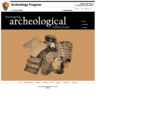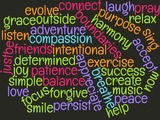
Just in Time Quick Check Make Observations and Inferences about Data Represented in a Circle Graph
- Subject:
- Mathematics
- Material Type:
- Assessment
- Provider:
- VDOE
- Author:
- VDOE
- Date Added:
- 10/07/2024

Just in Time Quick Check Make Observations and Inferences about Data Represented in a Circle Graph

Just in Time Quick Check Comparing Graphs

Just in Time Quick Check Collect, Organize and Represent Data

Just in Time Quick Check Read and Interpret Data

An online technical assistance and distance learning effort covering all aspects of curation -- caring for archaeological collections such as objects, records, reports, and digital data -- wherever they may be (in the field, the archeologist's office, the lab, or a repository).

Video Description: In this close-up video, Dr. Lola Fatoyinbo Agueh, a Research Physical Scientist at NASA's Goddard Space Flight Center, shares her love for exploring new places and passion for studying Earth, from the ground to satellite imagery. Video Length: 1:51NASA eClipsTM is a suite of online student-centered, standards-based resources that support instruction by increasing STEM literacy in formal and nonformal settings. These free digital and downloadable resources inform and engage students through NASA-inspired, real-world connections.NASA eClips Ask SME: Close-up with a NASA Subject Matter Expert videos are professionally developed to capture a glimpse of NASA SME's personal interests and career journeys. Each can be used to spark student interest and broaden their ideas of the STEM workforce. Additional videos in this series can be found by searching GoOpenVA using "NASA eClips Ask SME".

Video Description: Visit a lab at NASA's Johnson Space Center where scientists study meteorites. Learn how aerogel, the lightest material in the world helped capture pieces of a comet and return the comet dust to Earth. See what scientists can learn about our universe from these tiny particles. Video Length: 6:35.NASA eClips is a suite of online student-centered, standards-based resources that support instruction by increasing STEM literacy in formal and nonformal settings. These free digital and downloadable resources inform and engage students, through NASA-inspired, real-world connections.NASA eClips Our World videos (grades 3-5) help students understand the differences between science (the natural world) and engineering (the designed world). These video segments supplement elementary learning objectives not only in science, technology, engineering and mathematics, but also in reading, writing, visual and performing arts.

Video Description: What are citizen scientists? Why is their work so important to NASA? Join Dr. Michelle Thaller as she explains how the general public, using scientific protocols, careful observations and accurate measurements, can help NASA make exciting new discoveries. Find out how you can be a citizen scientist today. Video Length: 4:26.NASA eClipsTM is a suite of online student-centered, standards-based resources that support instruction by increasing STEM literacy in formal and nonformal settings. These free digital and downloadable resources inform and engage students through NASA-inspired, real-world connections.NASA eClips Real World segments (grades 6-8) connect classroom mathematics to 21st Century careers and innovations. They are designed for students to develop an appreciation for mathematics through real-world problem solving.

Video Description: Picture this. NASA sends a spacecraft to land on an asteroid, grab a piece of that asteroid, and then send that sample back to Earth to study. Learn more about all that NASA can learn about the formation of the Solar System from the close encounter of OSIRIS-REx with near-Earth asteroid Bennu. Video Length: 3:55.NASA eClipsTM is a suite of online student-centered, standards-based resources that support instruction by increasing STEM literacy in formal and nonformal settings. These free digital and downloadable resources inform and engage students through NASA-inspired, real-world connections.NASA eClips Real World segments (grades 6-8) connect classroom mathematics to 21st Century careers and innovations. They are designed for students to develop an appreciation for mathematics through real-world problem solving.

Video Description: Satellites are expensive to build and expensive to get into space. With all the changes in technology, is there a way to make satellites smaller? Find out just what NASA can pack into a 1U CubeSat, a satellite small enough to fit in your hand. Video Description: 3:24.NASA eClipsTM is a suite of online student-centered, standards-based resources that support instruction by increasing STEM literacy in formal and nonformal settings. These free digital and downloadable resources inform and engage students through NASA-inspired, real-world connections.NASA eClips Real World segments (grades 6-8) connect classroom mathematics to 21st Century careers and innovations. They are designed for students to develop an appreciation for mathematics through real-world problem solving.

Video Description: CubeSats are changing the way we collect information. They may be small, but these little satellites are helping us answer big questions. And using a swarm of CubeSats can give us simultaneous measurements without repeatedly sending commands to the satellite to tell it what to do.Video Length: 2:21.NASA eClipsTM is a suite of online student-centered, standards-based resources that support instruction by increasing STEM literacy in formal and nonformal settings. These free digital and downloadable resources inform and engage students through NASA-inspired, real-world connections.NASA eClips Real World segments (grades 6-8) connect classroom mathematics to 21st Century careers and innovations. They are designed for students to develop an appreciation for mathematics through real-world problem solving.

Video Description: Our Earth is a dynamic system with diverse subsystems that interact in complex ways.What are those subsystems and how do they interact?How are these subsystems and the global Earth system changing?What causes these changes?How does NASA monitor these changes?How can Earth system science provide societal benefit?Jessica Taylor, an atmospheric scientist at NASA Langley Research Center, and Dr. Steven Pawson, an Earth scientist from NASA Goddard Space Flight Center, help answer these questions and demonstrate how mathematical modeling helps scientists in their predictions of climate, weather, and natural hazards. Video Length: 5:02.NASA eClips Real World segments (grades 6-8) connect classroom mathematics to 21st Century careers and innovations. They are designed for students to develop an appreciation for mathematics through real-world problem solving.

Video Description: Balancing Earth's incoming and outgoing energy is like balancing an equation. When both are equal, Earth's energy is in balance. Learn more about how changes in this balance may impact Earth. Video Length: 2:56.NASA eClipsTM is a suite of online student-centered, standards-based resources that support instruction by increasing STEM literacy in formal and nonformal settings. These free digital and downloadable resources inform and engage students through NASA-inspired, real-world connections.NASA eClips Real World segments (grades 6-8) connect classroom mathematics to 21st Century careers and innovations. They are designed for students to develop an appreciation for mathematics through real-world problem solving.

Video Description: Earth's energy balance is very delicate. Small changes may have a big impact. How might changes in Earth's land and atmosphere impact this delicate balance? How might this knowledge be used to help us take better care of Earth? Video Length: 2:31.NASA eClipsTM is a suite of online student-centered, standards-based resources that support instruction by increasing STEM literacy in formal and nonformal settings. These free digital and downloadable resources inform and engage students through NASA-inspired, real-world connections.NASA eClips Real World segments (grades 6-8) connect classroom mathematics to 21st Century careers and innovations. They are designed for students to develop an appreciation for mathematics through real-world problem solving.

Video Description: In addition to planets and their moons, there are many small bodies orbiting the Sun. How did these bodies form? Learn more about comets and asteroids and the role these play in our Solar System, as well as NASA's Rosetta and NEOWISE missions. Video Length: 3:09.NASA eClipsTM is a suite of online student-centered, standards-based resources that support instruction by increasing STEM literacy in formal and nonformal settings. These free digital and downloadable resources inform and engage students through NASA-inspired, real-world connections.NASA eClips Real World segments (grades 6-8) connect classroom mathematics to 21st Century careers and innovations. They are designed for students to develop an appreciation for mathematics through real-world problem solving.

Video Description: Discover how NASA's Earth-observing satellites gather data to monitor food growth. Dr. Inbal Becker-Reshef describes how mathematics is used to interpret satellite data and describe vegetation and crop yield. Dr. Hannah Kerner shares how algorithms and models use NASA data to describe and predict food supply and food shortages. This work through NASA Harvest provides tools for farmers and governments to describe and predict food security worldwide. Video Length: 2:09.NASA eClipsTM is a suite of online student-centered, standards-based resources that support instruction by increasing STEM literacy in formal and nonformal settings. These free digital and downloadable resources inform and engage students through NASA-inspired, real-world connections.NASA eClips Real World segments (grades 6-8) connect classroom mathematics to 21st Century careers and innovations. They are designed for students to develop an appreciation for mathematics through real-world problem solving.

This lesson is for Networking and the Internet. The student will learn the difference between a network and the internet. They will be reminded of the importance of internet security and safety and how not everything on the internet is real. This lesson will use videos, books and hand on time to understand the how a network vs the internet works.

This is a follow-up lesson to One Word: My Mantra which will allow students to write their "one word" in a different language and create classroom decor that will remind them how the classroom community is linked together to support one another in staying focused on their goals.

Compare how computer memory and cache memory works by conducting a survey with various data collection methods to create a scatterplot.

In this lesson students will collect data from circle graphs and turn that data into bar graphs.